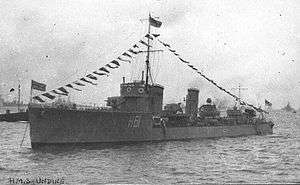HMS Urchin (1917)
HMS Urchin was a modified Admiralty R-class destroyer which served with the Royal Navy. It was the third ship in the Navy to be named after the sea urchin and the first in the class to be built by Palmers in Jarrow. It was launched in 1917 and served with the Grand Fleet during World War I, seeing action in the Second Battle of Heligoland Bight.
 Sister ship HMS Undine | |
| History | |
|---|---|
| Name: | HMS Urchin |
| Namesake: | Sea urchin |
| Ordered: | March 1916 |
| Builder: | Palmers Shipbuilding and Iron Company, Jarrow |
| Launched: | 7 June 1917 |
| Commissioned: | August 1917 |
| Decommissioned: | 7 January 1930 |
| Fate: | Sold to be Broken up |
| General characteristics | |
| Class and type: | Modified Admiralty R-class destroyer |
| Displacement: | 1,085 long tons (1,102 t) |
| Length: | 276 ft (84.1 m) |
| Beam: | 27 ft (8.2 m) |
| Draught: | 11 ft (3.4 m) |
| Propulsion: |
|
| Speed: | 36 knots (41.4 mph; 66.7 km/h) |
| Range: | 3,450 nmi (6,390 km) at 15 kn (28 km/h) |
| Complement: | 82 |
| Armament: |
|
Design
Urchin was 276 feet (84.12 m) long overall, with a beam of 27 feet (8.2 m) and a draught of 11 feet (3.35 m).[1] Displacement was 1,085 long tons (1,102 t).[2] Power was provided by three Yarrow boilers feeding two Parsons geared steam turbines rated at 27,000 shaft horsepower (20,000 kW) and driving two shafts, to give a design speed of 36 knots (67 km/h; 41 mph).[1] Two funnels were fitted, two boilers exhausting through the forward funnel. 296 long tons (301 t) of oil were carried, giving a design range of 3,450 nautical miles (6,390 km; 3,970 mi) at 15 knots (28 km/h; 17 mph).[3]
Armament consisted of three QF 4in Mk IV guns on the ship's centreline, with one on the forecastle, one aft on a raised platform and one between the funnels. They could elevate to 30°.[2] A single 2-pounder (40 mm) pom-pom anti-aircraft gun was carried, while torpedo armament consisted of two twin mounts for 21 in (533 mm) torpedoes.[1] Fire control included a single Dumaresq and a Vickers range clock.[4] The ship had a complement of 82 officers and men.[2]
Service
Urchin was one of ten R-class destroyers ordered by the British Admiralty in March 1916 as part of the Eighth War Construction Programme and was launched in June 1917.[3] On commissioning, Urchin joined the Thirteenth Destroyer Flotilla of the Grand Fleet.[5]
On 17 November 1917, Urchin took part in the Second Battle of Heligoland Bight in support of the 1st Cruiser Squadron, led by Vice-Admiral Trevylyan Napier in Courageous.[6] The destroyer formed part of small flotilla led by sistership Ursa, commanded by John Tovey, that attacked the German ships with torpedoes.[7]
At the end of World War I, the destroyer was still part of the Thirteenth Destroyer Flotilla under the cruiser Champion.[8] but was reduced to reduced complement on 8 February 1919.[9] Urchin was sold to Metal Industries of Charlestown, Fife on 7 January 1930 and broken up.[10]
Pennant numbers
| Pennant Number | Date |
|---|---|
| F99 | 1917[11] |
| F04 | 1918[11] |
References
- Gardiner, Robert; Gray, Randal, eds. (1985). Conway's All the World's Fighting Ships 1906–1921. London: Conway Maritime Press. p. 81. ISBN 0-85177-245-5.
- Parkes, Oscar; Prendegast, Maurice (1918). Jane’s Fighting Ships. London: Sampson Low, Marston & Co. Ltd. p. 107.
- Friedman, Norman (2009). British Destroyers: From Earliest Days to the First World War. Barnsley: Seaforth Publishing. p. 310. ISBN 978-1-84832-049-9.
- "Fire Control in H.M. Ships". The Technical History and Index: Alteration in Armaments of H.M. Ships during the War. 3 (23): 31. 1919.
- "Destroyer Flotillas of the Grand Fleet". Supplement to The Monthly Navy List: 12. October 1917. Retrieved 8 July 2018.
- ADM 137/584 Heligoland Bight Operation, 17 November 1917, Reports, 1917, retrieved 8 July 2018
- ADM 137/293 Gunnery and Torpedo Orders, 1917, 1917
- "Destroyer Flotillas of the Grand Fleet". Supplement to The Monthly Navy List: 12. January 1919. Retrieved 8 July 2018.
- "Urchin". Supplement to The Monthly Navy List: 879. April 1920. Retrieved 8 July 2018.
- Colleridge, J.J. (1987). Ships of the Royal Navy: The Complete Record of All Fighting Ships of the Royal Navy. Annapolis: Naval Institute Press. p. 423. ISBN 978-1-93514-907-1.
- Dittmar, F.J.; Colledge, J.J. (1972). British Warships 1914–1919. Shepperton: Ian Allan. p. 70. ISBN 0-7110-0380-7.
Bibliography
- Colledge, J. J.; Warlow, Ben (2006) [1969]. Ships of the Royal Navy: The Complete Record of all Fighting Ships of the Royal Navy (Rev. ed.). London: Chatham Publishing. ISBN 978-1-86176-281-8.
- Friedman, Norman (2009). British Destroyers: From Earliest Days to the Second World War. Barnsley, UK: Seaforth Publishing. ISBN 978-1-84832-049-9.
- Gardiner, Robert & Gray, Randal, eds. (1985). Conway's All The World's Fighting Ships 1906–1921. London: Conway Maritime Press. ISBN 0-85177-245-5.
- March, Edgar J. (1966). British Destroyers: A History of Development, 1892–1953; Drawn by Admiralty Permission From Official Records & Returns, Ships' Covers & Building Plans. London: Seeley Service. OCLC 164893555.